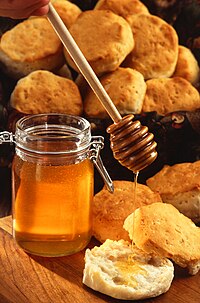
Photo from wikipedia
Simple Summary Honey bees collect pollen with different nutrients to meet their physiological metabolism needs and maintain colony development. The protein contents vary among bee pollens, and the nutritional level… Click to show full abstract
Simple Summary Honey bees collect pollen with different nutrients to meet their physiological metabolism needs and maintain colony development. The protein contents vary among bee pollens, and the nutritional level of pollen is mainly reflected in the amino acid composition of its proteins. In northern China, pear, rape, and apricot plants are monoculture plants grown in a large area, and their pollen is collected by honey bee colonies during the spring. However, honey bees showed a foraging preference for apricot or rape pollen. It is important to understand the differences in the amino acid levels of these three pollen species and the associated physiological metabolic responses in honey bees. In this study, we evaluated the differences in amino acid content and hemolymph metabolism in caged adult bees that were fed three different bee pollen types. The numbers and levels of essential amino acids in pear pollen were significantly higher than those in apricot and rape pollen. Furthermore, these three bee pollens induced different metabolic responses in adult honey bees of different ages. Overall, pear pollen had the highest nutritional value among the three bee pollens in terms of amino acid level, and bee pollen was shown to play an important role in the pathways related to amino acid and lipid metabolism in bees in early adulthood. Abstract Pollen is essential to the development of honey bees. The nutrients in bee pollen vary greatly among plant species. Here, we analyzed the differences in the amino acid compositions of pear (Pyrus bretschneideri), rape (Brassica napus), and apricot (Armeniaca sibirica) pollens and investigated the variation in hemolymph metabolites and metabolic pathways through untargeted metabolomics in caged adult bees at days 7 and 14. The results showed that the levels of five essential amino acids (isoleucine, phenylalanine, lysine, methionine, and histidine) were the highest in pear pollen, and the levels of four amino acids (isoleucine: 50.75 ± 1.93 mg/kg, phenylalanine: 87.25 ± 2.66 mg/kg, methionine: 16.00 ± 0.71 mg/kg and histidine: 647.50 ± 24.80 mg/kg) were significantly higher in pear pollen than in the other two kinds of bee pollen (p < 0.05). The number of metabolites in bee hemolymph on day 14 (615) was significantly lower than that on day 7 (1466). The key metabolic pathways of bees, namely, “sphingolipid metabolism (p = 0.0091)”, “tryptophan metabolism (p = 0.0245)”, and “cysteine and methionine metabolism (p = 0.0277)”, were significantly affected on day 7. There was no meaningful pathway enrichment on day 14. In conclusion, pear pollen had higher nutritional value among the three bee pollens in terms of amino acid level, followed by rape and apricot pollen, and the difference in amino acid composition among bee pollens was reflected in the lipid and amino acid metabolism pathways of early adult honey bee hemolymph. This study provides new insights into the physiological and metabolic functions of different bee pollens in bees.
Journal Title: Insects
Year Published: 2022
Link to full text (if available)
Share on Social Media: Sign Up to like & get
recommendations!